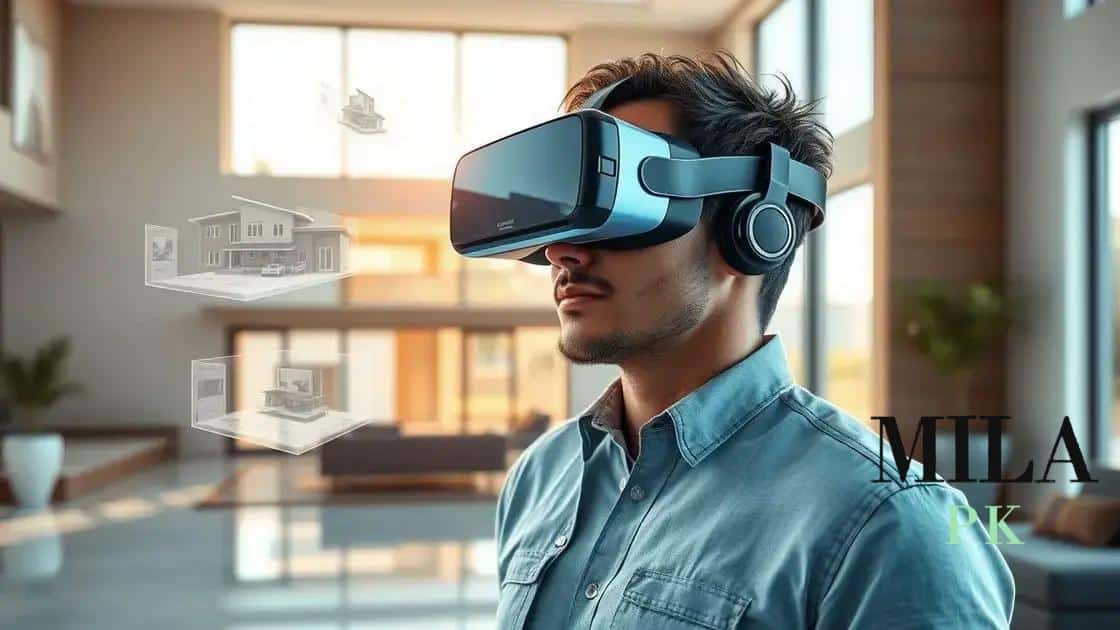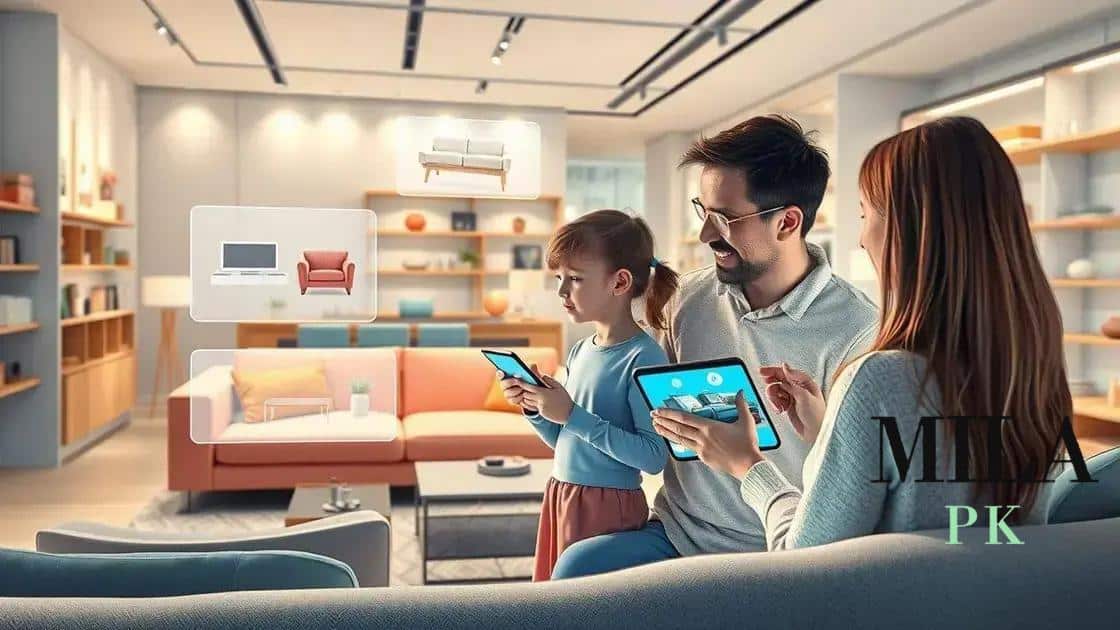Spatial computing used in real estate and retail: the future

Spatial computing used in real estate and retail by integrating digital and physical environments, enhancing customer experiences through technologies like augmented reality and virtual reality.
Spatial computing used in real estate and retail is changing the way we interact with our environments. Have you ever imagined exploring a property without leaving your home? This article dives into how this technology is being used today and what it means for the future.
Understanding spatial computing
Understanding spatial computing is essential in today’s technology-driven world. This innovative approach blends digital content with the physical environment, transforming how we interact with spaces.
At its core, spatial computing integrates physical and digital worlds using advanced technologies like augmented reality (AR), virtual reality (VR), and geographic information systems (GIS). Let’s explore how this works.
Key Components
To grasp the concept fully, consider these key components:
- AR: Overlaying digital information in real time.
- VR: Creating entirely immersive environments.
- GIS: Mapping and analyzing spatial data.
Each component plays a significant role in enhancing user experiences. For instance, AR can guide you through a property, giving context about features and amenities without being physically present.
Applications and Benefits
The applications of spatial computing are vast. In real estate, it allows potential buyers to visualize spaces and layouts through immersive tours. This can lead to quicker decisions and increased satisfaction.
Similarly, in retail, spatial computing can improve customer experiences. By using AR apps, shoppers can see how products fit in their homes before purchasing. This technology reduces guesswork and improves overall engagement.
Furthermore, as businesses adopt spatial computing, they can offer unique and personalized experiences that resonate with their customers. It creates a connection that traditional methods can’t match, paving the way for new market strategies.
In addition, many companies are investing in training employees using VR simulations. This method offers safe environments to learn and practice skills relevant to their jobs.
Overall, spatial computing is changing perspectives and expectations across various industries. Its ability to merge the physical and digital realms opens doors to innovations that enhance how we work, shop, and interact.
Applications in the real estate sector

Applications of spatial computing in the real estate sector are revolutionizing how properties are marketed and sold. This technology allows potential buyers to visualize properties in unique ways, enhancing their overall experience.
One major application is the use of virtual tours. These immersive experiences let buyers explore a home remotely, viewing every room and detail as if they were physically present. With VR headsets or even smartphones, clients can walk through properties, leading to more informed decisions.
Benefits of Virtual Tours
Virtual tours offer several advantages for both real estate agents and buyers:
- Increased reach: Buyers from different locations can view properties without traveling.
- Time-saving: Clients can narrow down their choices in less time.
- Enhanced engagement: Prospective buyers feel more connected to the property.
Another application is the use of augmented reality (AR) technology. AR apps allow potential buyers to see how their furniture would look in a particular space. By using a mobile device, they can overlay digital images of their belongings on top of real-world settings.
AR in Showcasing Properties
This application enhances property showings immensely. When clients can visualize their future homes more realistically, they are more likely to make a purchase. Additionally, it helps buyers decide on modifications or renovations before making a final decision.
The integration of spatial computing aids real estate agents as well. By providing innovative tools and visuals, agents can showcase properties more effectively. High-quality visuals capture buyers’ attention, which is crucial in a competitive market. This leads to better marketing strategies that attract interest and drive sales.
Moreover, spatial computing can simplify the process of assessing a property’s value. By analyzing geographic and spatial data, real estate professionals can provide clients with accurate information about market trends and neighborhood analytics.
How retail is leveraging spatial technology
How retail is leveraging spatial technology is transforming customer experiences and enhancing sales strategies. This technology allows retailers to integrate the digital and physical shopping environments, creating unique experiences for shoppers.
One effective way retailers are using spatial technology is through augmented reality (AR) apps. These apps give customers the ability to visualize products in their own space before buying. For example, a furniture store might offer an AR feature that shows how a couch fits within a customer’s living room.
Benefits of Augmented Reality in Retail
This application offers numerous advantages:
- Enhanced decision-making: Customers feel more confident in their purchases.
- Reduced returns: When buyers see how products fit their space, they make better choices.
- Increased engagement: Interactive experiences keep shoppers interested and entertained.
Another way retailers are leveraging spatial technology is by using virtual reality (VR) to create immersive shopping environments. Customers can explore a virtual store and interact with products as if they were physically there.
Creating Immersive Shopping Experiences
These virtual experiences are not only innovative but also fun. Imagine stepping into a VR store with your friends, browsing through products while chatting and making decisions together. This brings a social aspect to online shopping that traditional e-commerce lacks.
Additionally, retailers can utilize spatial computing for inventory management. By mapping their store layouts, they can easily track products and optimize restocking processes. This ensures shelves are always stocked and ready for customers, enhancing overall satisfaction.
Moreover, many retailers are using location-based services to provide personalized offers to shoppers. When a customer walks near a store, they might receive an alert about sales or new arrivals, enticing them to enter. This targeted approach leverages both spatial technology and mobile data, making marketing efforts more effective.
Benefits for consumers and businesses

The benefits of spatial computing for consumers and businesses are significant. This technology not only enhances the shopping experience but also streamlines operations in various industries.
For consumers, spatial computing makes shopping more enjoyable and efficient. With tools like augmented reality (AR), shoppers can visualize products in their own space. This helps them make better decisions and reduces the chances of returns.
Consumer Benefits
Here are some key benefits for consumers:
- Enhanced visualization: Shoppers can see how products look and fit in their homes before purchasing.
- Improved decision-making: Customers feel more confident in their purchases when they can visualize items.
- Convenience: Shopping can be done from anywhere, saving time and effort.
On the other hand, businesses also gain a lot from implementing spatial technology. Retailers can offer unique experiences that set them apart from competitors. By using virtual tours and AR in marketing efforts, companies can attract more customers.
Business Advantages
These are some key benefits for businesses:
- Increased customer engagement: Engaging shopping experiences lead to higher sales.
- Cost savings: Fewer returns mean less loss for retailers.
- Data insights: Spatial technology provides valuable consumer behavior data that helps tailor marketing strategies.
Moreover, as businesses adopt spatial computing, they can improve their efficiency. For instance, using spatial data to optimize inventory management allows businesses to keep track of stock levels effectively.
With better data and insights, companies can forecast trends and make informed decisions about product offerings. This proactive approach helps them stay ahead of the competition and meet customer needs more effectively.
Future trends in spatial computing
Future trends in spatial computing are set to reshape our interactions with technology and the world around us. As this technology continues to evolve, we can expect significant changes in various industries.
One key trend is the rise of more sophisticated augmented reality (AR) applications. These AR applications will become increasingly realistic and intuitive, allowing users to seamlessly blend digital information with their physical surroundings. For example, personalized shopping experiences will elevate consumer engagement as customers visualize products in their own environments.
Advancements in Technology
Technology advancements will drive these changes:
- Improved hardware: Developments in AR glasses and headsets will enhance usability.
- Faster processing: Increased computing power will enable real-time data processing for more interactive experiences.
- AI integration: Artificial intelligence will personalize user interactions, making experiences more relevant.
Additionally, spatial computing will play a pivotal role in smart cities. As urban areas become more interconnected, spatial technology will support efficient resource management. For instance, traffic patterns can be analyzed to optimize flow, reduce congestion, and improve public transport.
The Role of Data
Accessing and utilizing spatial data effectively will be crucial for businesses. Companies will harness data analytics to gain insights into consumer behavior and trends. This information will enable targeted marketing strategies and better decision-making.
Collaboration between industries will also be a trend to watch. From real estate to entertainment, diverse sectors will embrace spatial computing solutions to enhance their offerings. For example, real estate agents will use immersive technologies to showcase properties, while gaming companies will create richer experiences for players through AR and VR.
Finally, we can anticipate an increasing focus on user privacy and data security as more businesses adopt spatial technology. Ensuring secure transactions and protecting user data will be vital to building trust with consumers.
FAQ – Frequently Asked Questions about Spatial Computing in Real Estate and Retail
What is spatial computing?
Spatial computing integrates digital and physical environments, allowing users to interact with data in real-time using technologies like AR and VR.
How does augmented reality enhance shopping experiences?
Augmented reality allows customers to visualize products in their environment before buying, improving decision-making and reducing returns.
What benefits do businesses gain from spatial computing?
Businesses benefit from increased customer engagement, more effective marketing strategies, and improved inventory management through data insights.
What trends can we expect in the future of spatial computing?
Future trends include enhanced AR experiences, the rise of smart cities, deeper integration with AI, and a focus on user privacy and data security.





